





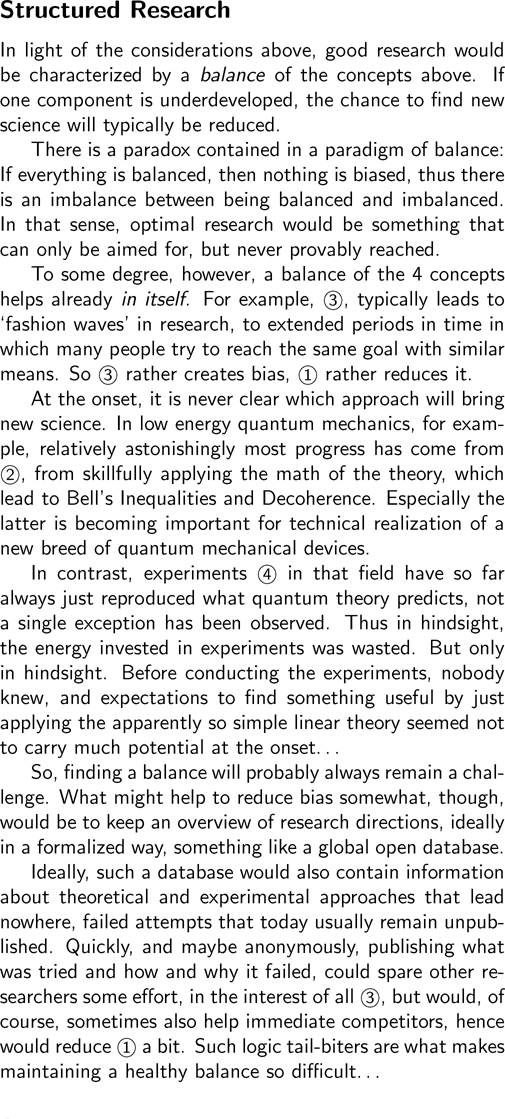
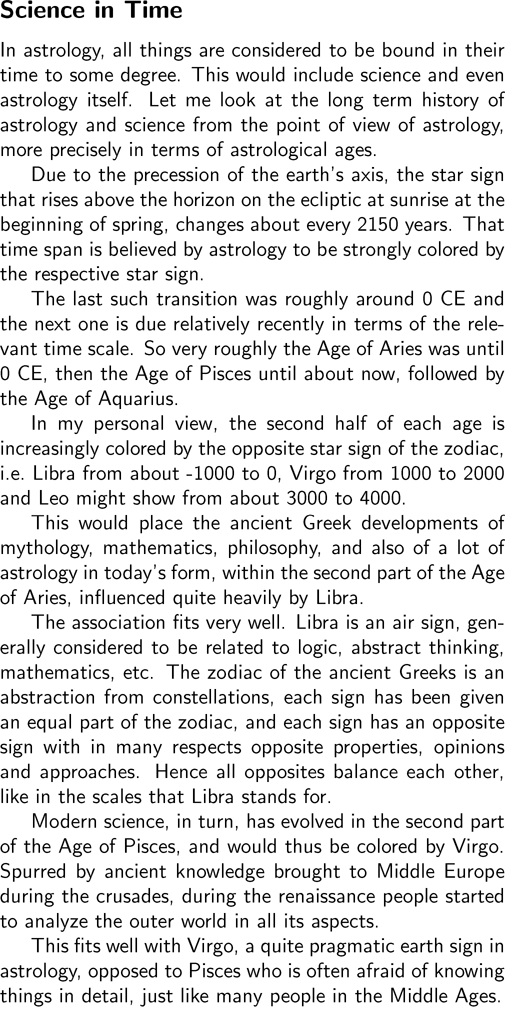
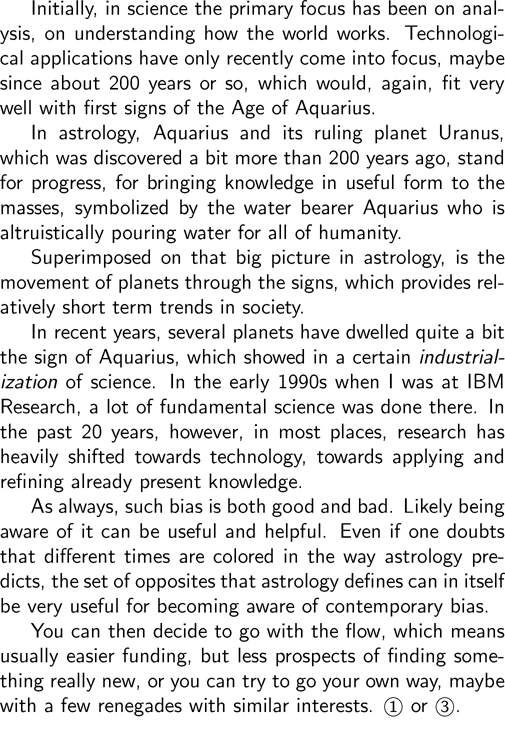
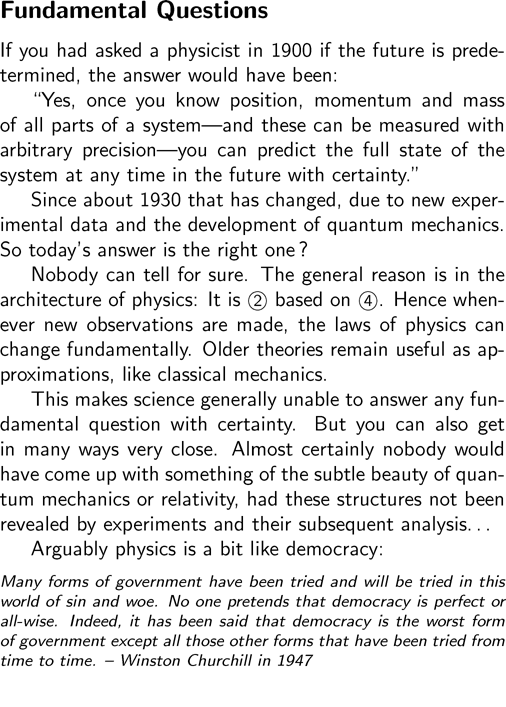
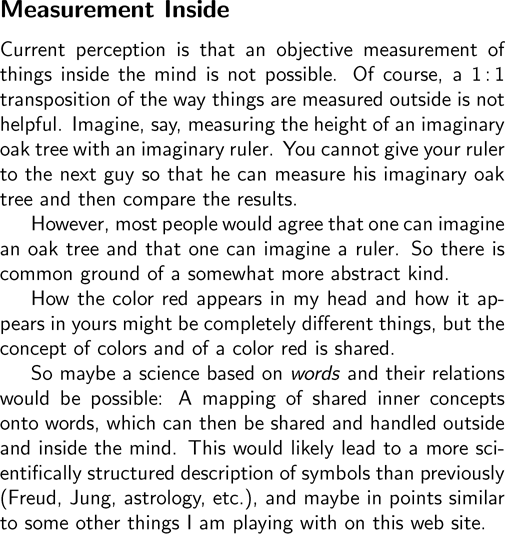
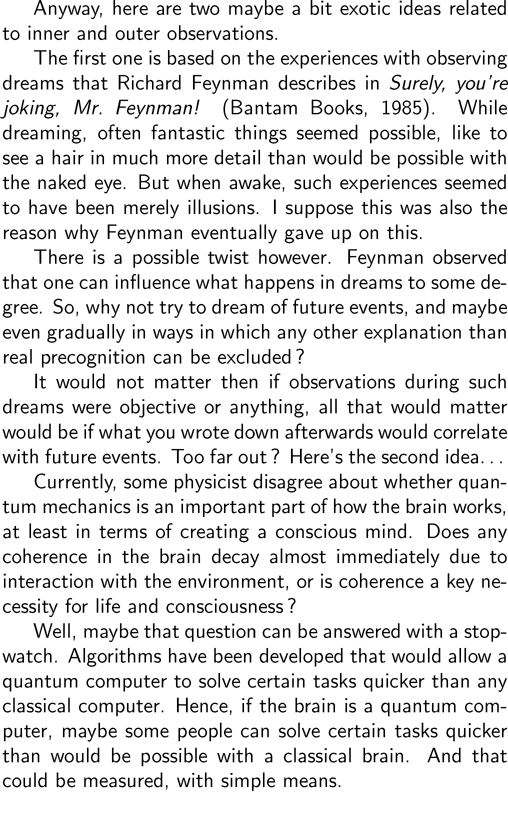
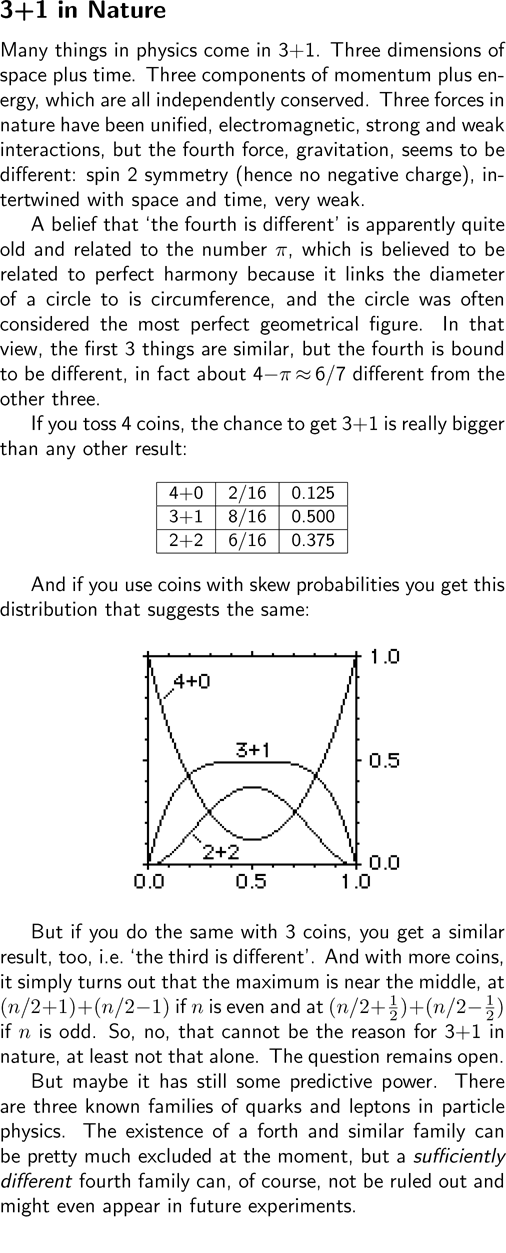
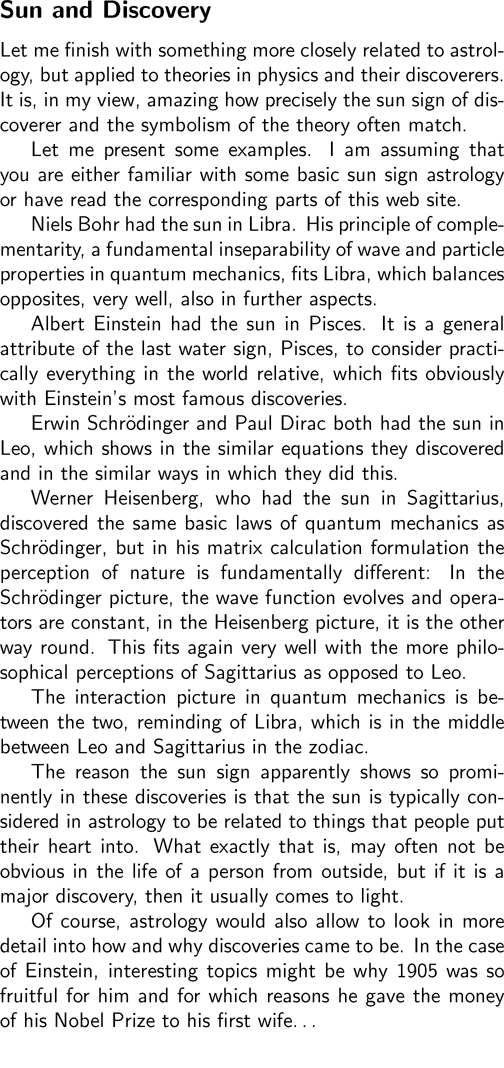





|
|

|
               |
|
|
science revisitedVarious symbolic takes at exact science, mostly related to physics: Its theories, how they emerge, and the people involved. Minimal style teasers for scientists... Architecture of PhysicsConsider this table that divides the world into 4 different concepts (inspired by the 4 classical elements):
At first sight, the conclusion would likely be that physics is made of (2) and (4), mathematical descriptions based on empirical evidence, without any (1) or (3). But let me look a bit more in detail into these concepts. Mathematical theories are for all that it appears purely (2), just logic, independently of any empirical observations. Physics uses math to describe logical connections between observed/measured numbers. In that sense, observation or measurement is fundamentally the process by which (4) is turned into numbers, on which then (2) can operate. This has the maybe somewhat unexpected consequence that math, (2), can a priori not be applied to describe measurement, simply because there are no numbers, yet. The perception of what exactly is an acceptable measurement in physics, is also not something that can be described by (2). Acceptable measurements, like using a ruler or reading a dial are just a minimal collective agreement, hence (3): the minimal common denominator of which observations made by different individuals can be considered independent of the individual who makes them. So there is a minimal amount of (3) in physics, and individual observations may not always be free of (1), at least that possibility cannot be formally excluded. Research in physics usually involves quite a bit of (1) and (3). Personal preferences and ideas, (1), are usually a main motivator that determines the kind of experiments or theoretical work a researcher conducts. Since research often needs funding and some experiments, like most prominently in particle physics, need machines bigger and more complex than any individual can build in a lifetime, (3) is also an important practical factor in research. Of course, once a new theory is found, the (1) and (3) elements involved in getting there no longer matter much. They become at most a matter of taste interpretation of the meaning of the theory, but they have no influence on specific predictions made by the theory. So an established theory is 'condensed back' to mostly (2) and (4). Structured ResearchIn light of the considerations above, good research would be characterized by a balance of the concepts above. If one component is underdeveloped, the chance to find new science will typically be reduced. There is a paradox contained in a paradigm of balance: If everything is balanced, then nothing is biased, thus there is an imbalance between being balanced and imbalanced. In that sense, optimal research would be something that can only be aimed for, but never provably reached. To some degree, however, a balance of the 4 concepts helps already in itself. For example, (3), typically leads to 'fashion waves' in research, to extended periods in time in which many people try to reach the same goal with similar means. So (3) rather creates bias, (1) rather reduces it. At the onset, it is never clear which approach will bring new science. In low energy quantum mechanics, for example, relatively astonishingly most progress has come from (2), from skillfully applying the math of the theory, which lead to Bell's Inequalities and Decoherence. Especially the latter is becoming important for technical realization of a new breed of quantum mechanical devices. In contrast, experiments (4) in that field have so far always just reproduced what quantum theory predicts, not a single exception has been observed. Thus in hindsight, the energy invested in experiments was wasted. But only in hindsight. Before conducting the experiments, nobody knew, and expectations to find something useful by just applying the apparently so simple linear theory seemed not to carry much potential at the onset... So, finding a balance will probably always remain a challenge. What might help to reduce bias somewhat, though, would be to keep an overview of research directions, ideally in a formalized way, something like a global open database. Ideally, such a database would also contain information about theoretical and experimental approaches that lead nowhere, failed attempts that today usually remain unpublished. Quickly, and maybe anonymously, publishing what was tried and how and why it failed, could spare other researchers some effort, in the interest of all (3), but would, of course, sometimes also help immediate competitors, hence would reduce (1) a bit. Such logic tail-biters are what makes maintaining a healthy balance so difficult... Science in TimeIn astrology, all things are considered to be bound in their time to some degree. This would include science and even astrology itself. Let me look at the long term history of astrology and science from the point of view of astrology, more precisely in terms of astrological ages. Due to the precession of the earth's axis, the star sign that rises above the horizon on the ecliptic at sunrise at the beginning of spring, changes about every 2150 years. That time span is believed by astrology to be strongly colored by the respective star sign. The last such transition was roughly around 0 CE and the next one is due relatively recently in terms of the relevant time scale. So very roughly the Age of Aries was until 0 CE, then the Age of Pisces until about now, followed by the Age of Aquarius. In my personal view, the second half of each age is increasingly colored by the opposite star sign of the zodiac, i.e. Libra from about -1000 to 0, Virgo from 1000 to 2000 and Leo might show from about 3000 to 4000. This would place the ancient Greek developments of mythology, mathematics, philosophy, and also of a lot of astrology in today's form, within the second part of the Age of Aries, influenced quite heavily by Libra. The association fits very well. Libra is an air sign, generally considered to be related to logic, abstract thinking, mathematics, etc. The zodiac of the ancient Greeks is an abstraction from constellations, each sign has been given an equal part of the zodiac, and each sign has an opposite sign with in many respects opposite properties, opinions and approaches. Hence all opposites balance each other, like in the scales that Libra stands for. Modern science, in turn, has evolved in the second part of the Age of Pisces, and would thus be colored by Virgo. Spurred by ancient knowledge brought to Middle Europe during the crusades, during the renaissance people started to analyze the outer world in all its aspects. This fits well with Virgo, a quite pragmatic earth sign in astrology, opposed to Pisces who is often afraid of knowing things in detail, just like many people in the Middle Ages. Initially, in science the primary focus has been on analysis, on understanding how the world works. Technological applications have only recently come into focus, maybe since about 200 years or so, which would, again, fit very well with first signs of the Age of Aquarius. In astrology, Aquarius and its ruling planet Uranus, which was discovered a bit more than 200 years ago, stand for progress, for bringing knowledge in useful form to the masses, symbolized by the water bearer Aquarius who is altruistically pouring water for all of humanity. Superimposed on that big picture in astrology, is the movement of planets through the signs, which provides relatively short term trends in society. In recent years, several planets have dwelled quite a bit the sign of Aquarius, which showed in a certain industrialization of science. In the early 1990s when I was at IBM Research, a lot of fundamental science was done there. In the past 20 years, however, in most places, research has heavily shifted towards technology, towards applying and refining already present knowledge. As always, such bias is both good and bad. Likely being aware of it can be useful and helpful. Even if one doubts that different times are colored in the way astrology predicts, the set of opposites that astrology defines can in itself be very useful for becoming aware of contemporary bias. You can then decide to go with the flow, which means usually easier funding, but less prospects of finding something really new, or you can try to go your own way, maybe with a few renegades with similar interests. (1) or (3). Fundamental QuestionsIf you had asked a physicist in 1900 if the future is predetermined, the answer would have been: "Yes, once you know position, momentum and mass of all parts of a system - and these can be measured with arbitrary precision - you can predict the full state of the system at any time in the future with certainty." Since about 1930 that has changed, due to new experimental data and the development of quantum mechanics. So today's answer is the right one ? Nobody can tell for sure. The general reason is in the architecture of physics: It is (2) based on (4). Hence whenever new observations are made, the laws of physics can change fundamentally. Older theories remain useful as approximations, like classical mechanics. This makes science generally unable to answer any fundamental question with certainty. But you can also get in many ways very close. Almost certainly nobody would have come up with something of the subtle beauty of quantum mechanics or relativity, had these structures not been revealed by experiments and their subsequent analysis... Arguably physics is a bit like democracy: Many forms of government have been tried and will be tried in this world of sin and woe. No one pretends that democracy is perfect or all-wise. Indeed, it has been said that democracy is the worst form of government except all those other forms that have been tried from time to time. - Winston Churchill in 1947 Measurement InsideCurrent perception is that an objective measurement of things inside the mind is not possible. Of course, a 1 : 1 transposition of the way things are measured outside is not helpful. Imagine, say, measuring the height of an imaginary oak tree with an imaginary ruler. You cannot give your ruler to the next guy so that he can measure his imaginary oak tree and then compare the results. However, most people would agree that one can imagine an oak tree and that one can imagine a ruler. So there is common ground of a somewhat more abstract kind. How the color red appears in my head and how it appears in yours might be completely different things, but the concept of colors and of a color red is shared. So maybe a science based on words and their relations would be possible: A mapping of shared inner concepts onto words, which can then be shared and handled outside and inside the mind. This would likely lead to a more scientifically structured description of symbols than previously (Freud, Jung, astrology, etc.), and maybe in points similar to some other things I am playing with on this web site. Anyway, here are two maybe a bit exotic ideas related to inner and outer observations. The first one is based on the experiences with observing dreams that Richard Feynman describes in Surely, you're joking, Mr. Feynman! (Bantam Books, 1985). While dreaming, often fantastic things seemed possible, like to see a hair in much more detail than would be possible with the naked eye. But when awake, such experiences seemed to have been merely illusions. I suppose this was also the reason why Feynman eventually gave up on this. There is a possible twist however. Feynman observed that one can influence what happens in dreams to some degree. So, why not try to dream of future events, and maybe even gradually in ways in which any other explanation than real precognition can be excluded ? It would not matter then if observations during such dreams were objective or anything, all that would matter would be if what you wrote down afterwards would correlate with future events. Too far out ? Here's the second idea... Currently, some physicist disagree about whether quantum mechanics is an important part of how the brain works, at least in terms of creating a conscious mind. Does any coherence in the brain decay almost immediately due to interaction with the environment, or is coherence a key necessity for life and consciousness ? Well, maybe that question can be answered with a stopwatch. Algorithms have been developed that would allow a quantum computer to solve certain tasks quicker than any classical computer. Hence, if the brain is a quantum computer, maybe some people can solve certain tasks quicker than would be possible with a classical brain. And that could be measured, with simple means. 3+1 in NatureMany things in physics come in 3+1. Three dimensions of space plus time. Three components of momentum plus energy, which are all independently conserved. Three forces in nature have been unified, electromagnetic, strong and weak interactions, but the fourth force, gravitation, seems to be different: spin 2 symmetry (hence no negative charge), intertwined with space and time, very weak. A belief that 'the fourth is different' is apparently quite old and related to the number π, which is believed to be related to perfect harmony because it links the diameter of a circle to is circumference, and the circle was often considered the most perfect geometrical figure. In that view, the first 3 things are similar, but the fourth is bound to be different, in fact about 4-π ≈ 6/7 different from the other three. If you toss 4 coins, the chance to get 3+1 is really bigger than any other result:
And if you use coins with skew probabilities you get this distribution that suggests the same: [image] But if you do the same with 3 coins, you get a similar result, too, i.e. 'the third is different'. And with more coins, it simply turns out that the maximum is near the middle, at (n/2+1)+(n/2-1) if n is even and at (n/2+1/2)+(n/2-1/2) if n is odd. So, no, that cannot be the reason for 3+1 in nature, at least not that alone. The question remains open. But maybe it has still some predictive power. There are three known families of quarks and leptons in particle physics. The existence of a forth and similar family can be pretty much excluded at the moment, but a sufficiently different fourth family can, of course, not be ruled out and might even appear in future experiments. Sun and DiscoveryLet me finish with something more closely related to astrology, but applied to theories in physics and their discoverers. It is, in my view, amazing how precisely the sun sign of discoverer and the symbolism of the theory often match. Let me present some examples. I am assuming that you are either familiar with some basic sun sign astrology or have read the corresponding parts of this web site. Niels Bohr had the sun in Libra. His principle of complementarity, a fundamental inseparability of wave and particle properties in quantum mechanics, fits Libra, which balances opposites, very well, also in further aspects. Albert Einstein had the sun in Pisces. It is a general attribute of the last water sign, Pisces, to consider practically everything in the world relative, which fits obviously with Einstein's most famous discoveries. Erwin Schrödinger and Paul Dirac both had the sun in Leo, which shows in the similar equations they discovered and in the similar ways in which they did this. Werner Heisenberg, who had the sun in Sagittarius, discovered the same basic laws of quantum mechanics as Schrödinger, but in his matrix calculation formulation the perception of nature is fundamentally different: In the Schrödinger picture, the wave function evolves and operators are constant, in the Heisenberg picture, it is the other way round. This fits again very well with the more philosophical perceptions of Sagittarius as opposed to Leo. The interaction picture in quantum mechanics is between the two, reminding of Libra, which is in the middle between Leo and Sagittarius in the zodiac. The reason the sun sign apparently shows so prominently in these discoveries is that the sun is typically considered in astrology to be related to things that people put their heart into. What exactly that is, may often not be obvious in the life of a person from outside, but if it is a major discovery, then it usually comes to light. Of course, astrology would also allow to look in more detail into how and why discoveries came to be. In the case of Einstein, interesting topics might be why 1905 was so fruitful for him and for which reasons he gave the money of his Nobel Prize to his first wife... leads
|
|||||||||||||||||||||